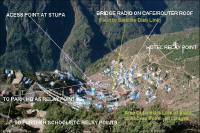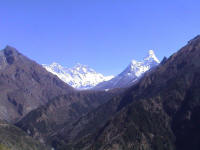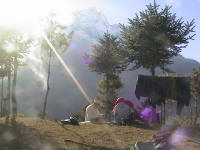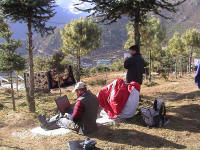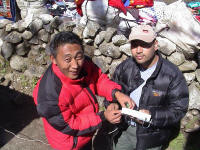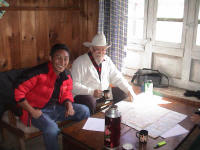Wireless in the Himalayas ~ Article and pictures
David R Hughes, Colonel (Ret) USA
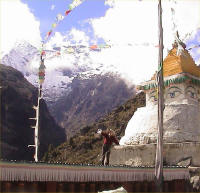
Dave on a Buddhist Stupa in Namche installing a radio. 20,664 feet Kongde
Mountain is behind.
“If you can connect up by wireless from Everest, you ought to be able to connect up anywhere”
Thus quipped a writer from the New York Times when she researched her story about the efforts Tsering Sherpa and Dave Hughes were going to make to operate the world’s highest ‘Cyber Café” at the 18,000 foot level Base Camp in May, 2003. This was to support climbers during the 50th Anniversary of the first climb of Mount Everest by Sir Edmund Hillary and Tenzing Norgay 50 years ago.
While that Everest Cyber Café operation made world news when all eyes were on the large number of climbers attempting the summit in May, a potentially far more significant wireless project was started in October further down at 12,000 feet in the Sherpa village of Namche Bazar. This article is about that effort to link up wirelessly, first, all the lodges and businesses in Namche – the last place where climbers and trekkers rest and acclimate themselves to the altitude before pressing on to their higher mountain goals. And then to launch the first very high country ‘distance learning’ venture for very poor Sherpa children whose education is very limited at best.
Beginnings
The roots of the Sherpa Wireless project were in the vision of 39 year old Tsering, a native of Namche, who had gotten part of his early education in Darjeeling, and through his travels and work in Asia and America where he saw the power and potential of the Internet. He was determined to bring that power to his home village and people, even though they lived in remote mountains where communications is very difficult, unreliable, and expensive. And some of it had already been destroyed by the Maoists who were blowing up Nepalese government telephone company towers, destroying the last link to Namche.
He already, by 2002, had taken over some communications equipment others had started to use, including a small radio-telephone network based on licensed frequencies, and completed his own ‘Cyber Café’ in Namche, with three desk top computers, and a satellite system that carried 128kbps of TCP/IP signal down to Kathmandu, 100 miles away, where it linked to the rest of the world via Worldlink Internet Service.
It was in the spring of 2002 when an American named Gordon Cook, who was interested in the Himalayas, visited Namche, heard Tsering’s vision and introduced him to me over the Internet.
Evolution of an Idea
I had done both community networking work in places like Montana, where I designed ways to link 114 one-room school houses to the world, and then extended wireless for the National Science Foundation to places including Ulaanbatar, Mongolia, Alaska, the jungle of Puerto Rico and my own Old Colorado City. I was more than familiar with what it would take for Tsering to realize his vision.
I also knew, from my philosophy of ‘fitting technology to cultures’ and not ‘cultures to technology’ that I needed to learn a lot about the Sherpa, and Nepalese cultures, their economics, and politics as it would affect Namche if I were to be able to give the right kind of advice on how to make the networking useful to the economy, education, and culture of the Sherpas. At the simplest technical level, operating computers or radios at 12,000 feet in Nepal is little different from operating and maintaining them in high Colorado. But from that point on – the language differences, the levels of education and experience with computers or other technical devices - in a village which had never used telephones, or had electricity, much less ‘personal’ computers, would make it a steep learning curve.
I set about learning by email, which Tsering could use, writing English, although it was a chore for him, and by study of books and on the Internet about the Sherpa culture and Nepalese Kingdom, and from information from Gordon Cook from his previous trips there.
First, Base Camp
In early 2003, a novel idea was hatched by Tsering Sherpa and the Namche based manager of the Sargamatha Pollution Control Committee – SPCC – a partially Nepalese-government funded NGO which had the responsibility for ‘managing’ the ‘Park’ and travellers in it containing the highest mountains in the world. They wanted to set up the world’s highest ‘Cyber Café’ at the 18,000 foot level Base Camp used by all the climbers going up the Nepalese side of Everest. It would serve, for a fee, the hundreds of climbers and their expedition parties, the press, and medical staffs that would converge on the Base Camp in May 2003. The profits, if any, would be split between SPCC, Wordlink, and Tsering’s Namche Technical Services. It would be a benefit to SPCC.
Tsering recruited Dileep Agrawl, owner of Worldlink, Nepal’s largest Internet Service Provider in Kathmandu, who had much experience with Satellite Internet links and could provide the Satellite base unit.
The plan was to set up the Satellite Base Station at the Base Camp, linked to the Internet via a geosynchronous satellite and provide e-mail, web browser and perhaps even voice over the Internet to the climbers and their support personnel camped for a month or more at Base Camp at the foot of the great Ice Fall at 18,000 feet, from where the hard technical climb up the mountain starts.
Simple concept. Right? Wrong! There were plenty of obstacles. The Base Camp sits on the Khumbu Glacier that moves between three and four feet a day down the flat valley. Keeping the satellite aligned and linked would be a constant headache. Secondly, Base Camp was so low in the valley that the Nuptse and Lhotse mountain masses blocked the best line of sight to the satellite low in the southern sky. They would have to peek through the passes between them, which often would be thick with clouds – which could attenuate the signal or even block it entirely during mountain storms.
So Tsering contacted me in Colorado. The solution was, to me, straight forward in concept. Place the Satellite Base unit on the other side of the Khumbu valley on higher, solid ground that sloped up toward 23,490 foot Pumori mountain, and link the Base Camp to the Satellite Base by a 4 kilometer 802.11b radio wireless data link between a radio at the satellite, and the other in the Cyber Café. Each radio would be fitted with a 13.5 dB gain directional antenna. All powered by plenty of batteries and solar panels packed up there on the backs of Yaks and Sherpa porters.
I persuaded Cisco Corporation to donate three Cisco Aeronet Wi-Fi 350 Access Point radios with the antennas. They got the radios to Nepal just in time.
The long and short of it was that solution worked, after taking 18 yaks to carry everything up from Namche. There were many minor problems, all solved. Doing the simplest things was hard, slow, work at that altitude. The Cyber Café in the tent at Base Camp provided, at $1 a minute, the kind of digital link to the rest of the world that costly satellite voice telephones brought by many parties could not. In one case a climber manager said the Base Camp Cyber Café saved him $10,000 in communications costs.
There was tremendous world wide publicity for several months over the ‘World’s Highest Cyber Café’ operating during the two short climbing season months. Tsering became famous. And I did not even have to go there. I just give advice and evaluated feedback, by email.
Wireless Namche
All the above was preparation - a sort of rehearsal, and lessons learned - for what Tsering Sherpa really wanted – which was the wireless connecting up of Sherpas in his 12,000 foot high Namche community. Which is the village on the trail to Everest, which all Trekkers and Climbers use as the stopping-over place to acclimate themselves to the altitude, rest, and organize before pressing on. Its their last place to communicate from.
I had gotten to know Tsering, and his vision for his people, and understood the economic problems that Namche faced, with boom and bust tourism, overdependence on one source of revenue, and only six months of activity. And the fact that the children of Namche and the surrounding villages were still – in spite of many schools having been built by the Hillary Trust – poorly educated. Most of the children faced a life of portering heavy loads for wealthy Westerners up and down the Solo Khumbu for $5.00 a day. They had little future.
So during the summer of 2003 I worked out the details with Tsering by email and occasional VOIP calls from his Cyber Café of what it would take to extend wireless broadband links to many Lodges where trekkers and climbers stayed from the location of his Namche Cyber Café and its satellite base station, and 4 desktop computers inside.
Especially I studied both topographic maps of Namche and the surrounding area, and photographs from the high country, and some aircraft, from above. For the key would be the validity of my rough, distant, ‘wireless site survey’ for how many of what type radios, connectors, cables, power supplies, and all the myriad bits and pieces I had to take in there in order to reach the whole village . It would be a two day trek with Sherpa porters, to get anything up there from the nearest small aircraft landing field, and being over 100 miles from Kathmandu would be too far to get something overlooked and needed, even if it could be procured there.
My boots on the ground military experience going back 50 years to the Korean War, from reading maps to planning operations with attention to detail, and my 15 years experience specifically deploying unlicensed spread spectrum radios in remote areas helped immensely.
One look at the aerial view of Namche shows its unique topography. A high bowl with buildings, including the lodges, terraced upward from the central “Tibetan Marketplace’ (thus the name Namche Bazar) with a Buddhist Stupa at one end – a drop off precipice to the valley far below behind it, and a giant very steep mountain 2km across from opening of the bowl.
At once that told me that if an Access Point base radio could be placed right, radios in the lodges could ‘see’ the base radio at a pretty short range – less than a mile. It also told me the best place would be right on the sheer face of that facing mountain. A daunting proposition. And that the roofs of the lodges, being made of tin, would be bad to try and punch through from above. so the 2.4ghz signals should try to go through the concrete walls on the sides.
I knew that the Cisco radios I had gotten for the one-time Base Camp project would not be the best radios for the Namche project or for future expansion in Sherpa villages by Tsering. I selected a brand I had some experience and knowledge about - Wi-Fi 802.11b radios from Smartbridges of Singapore. I picked them because:
They were rated outside to -40 degrees F. The Cisco’s only went to 0.
They operated with Power over Ethernet POE cabling, which could work with either battery or grid power
They had excellent receiver sensitivity
They could be run on 12volts DC – plain vehicle-class battery. The Cisco’s required 24 to 48v. Multiple batteries.
They were simpler to configure than the Cisco’s. Nothing fancy.
They had standard ‘N’ connectors right at the radio – separate pigtails were not required to link with external antennas.
Finally they were much less expensive than the Cisco family, from a high of $330 down to $107 for USB port driven client radio for use in the Lodges. From one third to one half the cost of Ciscos and similar quality corporate radios. And they could come from a closer Asian source than from US manufacturers, Singapore.
I pledged to donate $3,000 worth of Smartbridges with associated hardware and fixtures including signal splitters, battery regulators, cable tools to the project.
There was something else I felt we needed. If we were going to connect up a Sherpa school to the net, and try to - through ‘Distant Learning’ techniques - teach Sherpa children English, Math, Science and other subjects beyond the materials or skills of the Nepalese teachers who generally ran the schools in the high country, we needed reliable voice sound. Tsering had made it clear that unless the children learned English they could not even qualify as guides for Trekkers or climbers.
So I once again contacted Cisco and asked them if they would donate four Voice over IP (VOIP) telephone sets to the cause, even though I had not bought their radios. And would they configure them for SIP (Session Initation Protocol) – point to point IP connectibility, so that the classes could have voice over speaker phones. And once the 24 by 7 wireless and satellite connections were in place, there would be no cost of ‘crossing over’ into the switched telephone networks in the US or other places. Essentially ‘free’ voice calling. Once again they came through. Cullen Jennings, an expert in VOIP voluntarily configured 4 7960 Ciscos for our precise needs, right down to the fixed IP addresses in Namche they would use. I registered their SIP protocols through IPTEL.COM voip registry in Germany – a free server service that stores the numbers for voip phones, so other SIP phone users can reach them from anywhere on the net.
Finally Jim Forster of Cisco, taken with the project, offered $2,000 personally so I could buy 2 late-model Windows computers for the classroom in Kathmandu and get them to Namche for the students to use once their classes started. With two 70 pound bag weight limits for air travel from the US I could not buy them, even more cheaply, in the US and carry them to Nepal with all the other impedimenta I was going with.
After frequent email and phone calls, one of my employees Marty Yazlowitz and I configured and pretested every radio and network connections, as well as the Cisco phones ahead of time in a short range shadow network. There would be little opportunity to start wrestling with IP address, netmasks, and router configurations once I got to Namche. No local help desks to call!
The Trek
I also had to get my 75 year old body in physical shape for the trip. I would have to fly into Lukla, Nepal from Kathmandu, a very small and scary airport with a 20 degree slope, on the side of a mountain part way up the Solo Khumbu. And then, with hired Sherpa porters, trek for at least 2 days over 12 rough trail miles and over 6 hanging bridges up 3,000 feet more to Namche Bazar at its 12,000 feet elevation. No FedEx delivery there!
But living at 6,500 feet in Colorado, thus not too worried about altitude sickness at 12,000 feet, and having long ago been a hard walking infantry officer, I faithfully climbed daily up Barr Trail toward 14,000 foot Pikes Peak for six weeks until I was fit to tackle the trail to Everest.
On 21 October, 2003 I flew through Frankfurt, Germany, and Doah, Quatar to Kathmandu with my radios and very advanced internet phones, plus my own laptop and a very small, Sony camcorder with which I could take and send pictures from and even video clips.
On the trail I met interesting people from all over the world. Most were taken aback at my age making this trip. But to the Sherpas that is everyday life into their 80s. I met Apa Sherpa who has summited Everest 13 times.
With Tsering who met me, and Pavan Shakya, a lowland Nepalese employee of Worldlink who desperately wanted to learn the secrets of wireless from me, we plugged away up the mountain and got there with all the technical equipment intact.
Training and Installation
My personal method of working with people who have never installed and operated wireless devices – and very few have - is to teach them progressively what I am doing, explaining everything theoretically, then doing the first installation myself while explaining everything practical while they watch, then make them install the second one themselves, me watching and critiquing, then, expect them to do all the rest, answering questions by email, or Voice over IP.
I went over what the architecture would be, what is important in terms of Line of Sight, obstacles, potential interference, possible need for relay radios, and how to do a rough walk-around site survey before starting installing anything. I want them to ‘visualize’ in their minds eye what the invisible wireless network would look like. So they would get used to looking for high points, clever alternative locations, where radio relays might go, obstacles which will attenuate the signals, and a rough idea of ‘distance’ the radios can reach, with a variety of external omni and directional antennas. We started that process the first, rainy day.
It was clear to me I had, ‘visualized’ Namche properly from maps and a National Geographic aerial photo, and my years of experience to envision a practical layout of radios within the village, with its steep terraced slopes.
But there remained one large question mark. Where to put the key “Access Point” radio that would have to ‘see’ the whole village from one point? And towards which all the client and relay radios would have to point. Given the 28 degree ‘fan’ from the directional antenna built into the primary Access Point Radio, I was afraid it would have to be placed across the valley on the steep side of 20,644 foot Kongde mountain, at least 2km away from the center of Namche to ‘see’ with enough strength the whole town. My calculations of radio power and antenna gain told me that would be an acceptable distance for the RF signal to go, with 15db of ‘margin’ as my benchmark for a reliable radio link.
But looking directly across the deep gorge at the mountain I saw it was almost a sheer cliff. Awesome in fact. With small waterfalls trickling down its face. Tsering joked that when the water froze crazy ice climbers, would take 4 days to climb to the top. I asked him how long it would take he and other Sherpas to go around to the top, and rappel down to anchor a radio, with batteries, and solar panels. He said it would take at least 12 hours just to get there. Out of the question. Too many variables. Very very risky.
Then, even though Tsering knew little except what he had seen at Base Camp months before about Wi-Fi radios, he said “Why don’t you put it on the Stupa at the bottom of the Tibetan Marketplace?” I said “But that is a religious site, isn’t it? Won’t your Sherpa neighbors be offended if this crazy American puts a modern radio up on its traditional face?” His answer showed how little I still knew about the Sherpa culture and the nature of their religious icons. “Its not really a temple. No one would object. Besides, my family owns one of the four posts that surround it.”
With nothing to lose, and no better suggestion, we set about to mount the Access Point Radio up about 10 feet above the ground on one of the poles, and aimed it up to the center of Namche. The 28 degree fan only subtended about half the town. I feared there would be insufficient signal power to reach the lodges to each side, up to 90 degrees away from the direction the antenna was pointed. Also after Tsering got a 220v power line run to the inner wall of the Stupa, we strung the power line from the pole right over a bank of Prayer Wheels. That looked ugly to me. But cheerfully Tsering said ‘Lets just hang prayer flags on the wire!” So he did, and nobody was offended, at any of this. Just curious.
To my great relief, when I dispatched three of the Cyber Café staff members to walk with laptop computers and small USB powered Wi-Fi radios up and down each side of the Namche bowl to each lodge to see what our coverage was, everything worked! The ‘side lobe’ power that radiates out at 90 degrees from the directional antenna that concentrates the power forward, was just strong enough to reach inside the lodges to the side. They were only about 150 feet away, and that helped.
Then quickly we were able to put a Client, of Bridge, radio on the roof of the Cyber Café building, using a wooden post (very few usable pipes were around, and even wood is scarce), then drop the Power over Ethernet cable into the computer room, hook it to the Router, which was connected to the IP Satellite dish, and we had end to end wireless connectivity from any lodge to the Internet. Mission largely accomplished!
After that fundamental ‘backbone’ link was established the tricky remaining task was to see how we could get the wireless signal, first up onto the ‘shelf’ of land above Namche where the SPCC Park Headquarters was, then to the Army barracks close by – both of whom wanted Internet access, and then with a Relay radio from there to a Sherpa ‘middle’ school. We first were prepared to extend the link to the relatively well endowed Hillary School which lay north 2km. The headmaster had showed some interest in being connected before I got there. But in the end Tsering could not come to terms with the school. They wanted a totally free lunch. No way. Tsering was in business. The satellite service costs him $1,200 a month. So the eager Headmaster of the very poor Thame school, 4km away whose girls would travel to Namche to do traditional dances to raise money for books, jumped in to take advantage of the possibility of getting his kids educated from afar – real distance learning, where the last link to the Internet would be wireless. He would happily pay the $200 a month needed.
This is where the Cisco 7960 VOIP telephones configured for SIP connectivity, came in. SIP protocol phones are IP point to IP point phones, which cost nothing above the basic net connection to use. The basic idea was to extend the wireless link to the school from Namche to Thame, requiring an intermediate relay radio, put a small router in the school, there, connect up the two new Windows computers Jim Forster had donated, and put in one of the Cisco IP Phones with speaker there in the classroom. Then let all 9 Sherpa children and their Nepalese teacher hear distant Mingma Sherpa who grew up in Namche, and now lives in Pittsburgh, USA, use his own Cisco IP phone teach them, first, oral English, and then written English via email, and later other subjects through the very long computer connection. The only hard part from this point on would be how to set the class schedule, since Pittsburgh is 10 hours different from Nepal – a 9 AM class in Thame would require that Mingma be up at 11 PM in Pittsburgh to teach it!
Closure
With the major wireless deployment tasks completed, and after my calculating what it would take for a climber on the summit of Everest – which I could see from Namche, to send and receive email wirelessly from a handheld PDA, or to put a telescope cam at Namche to watch climbers the last few hundred meters above the Hillary Step, I returned to the US. I remain in touch by email and VOIP, including ‘Freeworldialup’ software phones which are the Next Big thing.
And let Tsering, Santosh, and the little band of Internet pioneers carry on themselves.
Dave Hughes
Old Colorado City Communications
US 1-408-907-4132
